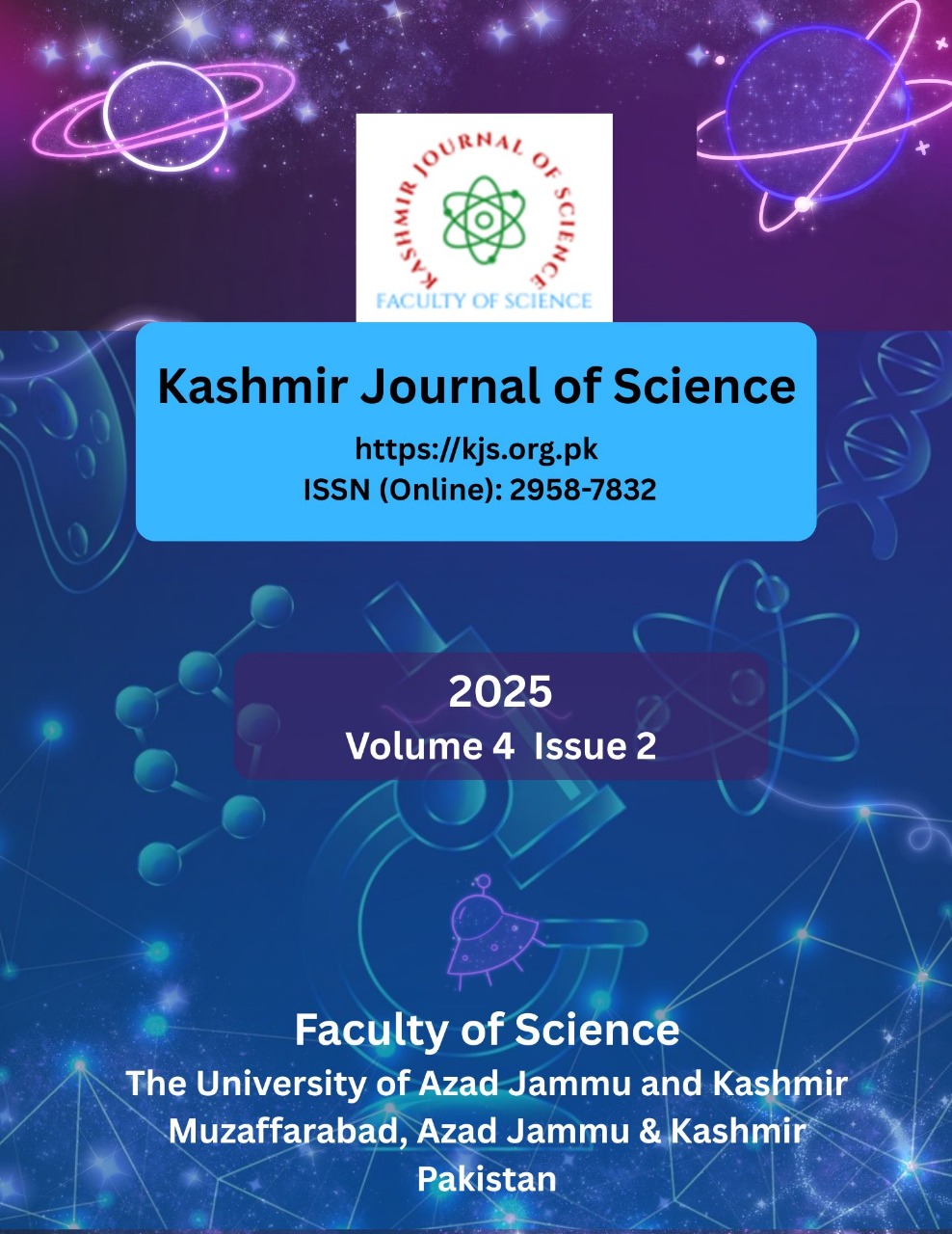CHEMICAL FINGERPRINT AND BIOACTIVITIES OF SOLANUM NIGRUM L. AND SOLANUM MELONGENA L. - A COMPARATIVE ASSESSMENT OF TWO SOLANACEAE SPECIES
DOI:
https://doi.org/10.63147/krjs.v4i2.142Keywords:
Solanum nigrum, Solanum melongena, hemolysis, alpha-amylase, antimicrobialAbstract
Medicinal plants have a vital role in health and beyond traditional medications; these are part of modern pharmaceutical landscape. The present study was designed to compare and contrast phytochemistry and bioactivities of Solanum nigrum (SN) and Solanum melongena (SM); two species of Solanaceae family. Aqueous leaf extracts were used to assess total phenolic contents (TPC) and total flavonoid contents (TFC), free radical scavenging activity, alpha amylase inhibition (antidiabetic activity), antimicrobial and cytotoxic activities along with chemical fingerprint by Fourier transform infrared spectroscopy (FTIR). TPC in SN and SM extracts were 32.73 ± 2.08 mg GAE/100g and 43.98 ± 0.12 mg GAE/100g respectively. TFC of SN extract was 69.69± 0.538mg CE/100g and TFC of SM was 89.545± 0.19mg CE/100g. SN and SM extracts showed 70.52 ± 0.73 % and 74.13 ± 0.60 % free radical scavenging capacity respectively. In antimicrobial assay, SN showed antimicrobial activity against E. coli with 9mm area of growth inhibition and 12 mm inhibition zone was observed against S. aureus. Meanwhile, SM showed 9 mm of inhibition zone against E.coli as well as 9.3mm of inhibition zone against S. aureus, which indicates the presence of antimicrobial potential. SN and SM exhibited 28.64±3.22% and 28.2±2.21% inhibition of amylase enzyme. Aqueous extract of Solanum nigrum showed 10.76% hemolytic activity, aqueous extract of Solanum melongena showed 5.27% hemolytic activity and positive control had 94.87% hemolytic activity. FTIR spectra confirmed the presence of diverse secondary metabolites. Both species of Solanaceae family exhibited analogous anti-diabetic and anti-microbial activities. However, S. melongena was slightly less toxic as compared to Solanum nigrum. These are preliminary assessments that have contributed to the existing data but in real-world scenario, animal trials can better fabricate their application in medicine.
References
Ahmed T, Shahid M, Noman M, Niazi MBK, Mahmood F, Manzoor I & Chen J. 2020. Silver nanoparticles synthesized by using Bacillus cereus SZT1 ameliorated the damage of bacterial leaf blight pathogen in rice. Pathogens. 9(3): 160. https://doi.org/10.3390/pathogens9030160
Ali T, Hussain F, Naeem M, Khan A & Al-Harrasi A. 2022. Nanotechnology approach for exploring the enhanced bioactivities and biochemical characterization of freshly prepared Nigella sativa L. nanosuspensions and their phytochemical profile. Frontiers in Bioengineering and Biotechnology. 10(1), 888177. https://doi.org/10.3389/fbioe.2022.888177
Bernela M, Seth M, Kaur N, Sharma S & Pati PK. 2023. Harnessing the potential of nanobiotechnology in medicinal plants. Industrial Crops and Products. 194, 116266. https://doi.org/10.1016/j.indcrop.2023.116266
Contreras-Angulo LA, Moreno-Ulloa A, Carballo-Castañeda RA, León-Felix J, Romero-Quintana JG, Aguilar-Medina M & Heredia JB. 2022. Metabolomic analysis of phytochemical compounds from agricultural residues of eggplant (Solanum melongena L.). Molecules. 27(20):7013. https://doi.org/10.3390/molecules27207013
Deng J, Wang L, Jin Q, Zeng J, Xu J, He X & Wang Y. 2023. Anti-inflammatory steroids from the stems of Solanum nigrum L. Phytochemistry. 210,113667. https://doi.org/10.1016/j.phytochem.2023.113667
Dunkwu-Okafor A, Atuanya EI & Obayagbona ON. 2020. Proximate, phytochemical profiling and antibacterial activity of aqueous Solanum melongena Linn leaf extract. Journal of Science and Technology Research. 2(4). https://doi.org/10.37933/nipes/2.4.20205
Gasti T, Dixit S, Sataraddi SP, Hiremani VD, Masti SP, Chougale RB & Malabadi RB. 2020. Physicochemical and biological evaluation of different extracts of edible Solanum nigrum L. leaves incorporated chitosan/poly (vinyl alcohol) composite films. Journal of Polymers and the Environment. 28:2918-2930. https://doi.org/10.1007/s10924-020-01832-6
Hussain F, Akram A, Hafeez J & Shahid M. 2021. Biofunctional characterization of red, black and white ginseng (Panax ginseng Meyer) root extracts. Revista Mexicana de Ingeniería Química. 20(1):173-184. https://doi.org/10.24275/rmiq/Bio1735
Kamran U, Bhatti HN, Iqbal M, Jamil S & Zahid M. 2019. Biogenic synthesis, characterization and investigation of photocatalytic and antimicrobial activity of manganese nanoparticles synthesized from Cinnamomum verum bark extract. Journal of Molecular Structure. 1179:532-539. https://doi.org/10.1016/j.molstruc.2018.11.006
Karahan F. 2023. Evaluation of trace element and heavy metal levels of some ethnobotanically important medicinal plants used as remedies in Southern Turkey in terms of human health risk. Biological Trace Element Research. 201(1): 493–513. https://doi.org/10.1007/s12011-022-03299-z
Kauser A, Shah SMA, Iqbal N, Murtaza MA, Hussain I, Irshad A & Riaz M. 2018. In vitro antioxidant and cytotoxic potential of methanolic extracts of selected indigenous medicinal plants. Progress in Nutrition. 20(4): 706-712. https://doi.org/10.23751/pn.v20i4.7523
Khalawi AHF. 2022. Study to detect cytotoxicity of the eggplant plant (Solanum melongena L). University of Thi-Qar Journal of Agricultural Research. 11(2): 36-44. https://doi.org/10.54174/UTJagr.Vo11.N2/04
Kumar P, Kumar J, Kumar R & Dubey RC. 2016. Studies on phytochemical constituents and antimicrobial activities of leaves, fruits and stems of Solanum nigrum L. Asian Journal of Plant Science and Research, 6(4): 57-68. https://doi.org/10.21048/IJND.2021.58.S1.27538
Mansurat AI, Dandago MA & Diya’udeen HB. 2023. Phytochemical contents and antioxidant potentials of Eggplants from Kano State, Nigeria: A Review. https://dx.doi.org/10.4314/dujopas.v9i1a.16
Noreen A, Hussain F & Shahid M. 2020. Insights on the antioxidant, antidiabetic, antiamnesic, cytotoxic, thrombolytic and antibiofilm activities of Stevia rebaudiana leaves. Progress in Nutrition. 22:1-9.
Okeke PN, Ilodibia CV, Ngene AC, Iroka FC, Aziagba BO. 2020. Anatomical and biochemical studies of Solanum melongena and Solanum nigrum. Universal Journal of Plant Science, 8(1), 11 - 16. DOI: 10.13189/ujps.2020.080102.
Oluwagunwa OA, Alashi AM & Aluko RE. 2021. Inhibition of the in vitro activities of α-amylase and pancreatic lipase by aqueous extracts of Amaranthus viridis, Solanum macrocarpon and Telfairia occidentalis leaves. Frontiers in Nutrition. 8: (2021) 772903. https://doi.org/10.3389/fnut.2021.772903
Ramesh M, Anbuvannan M & Viruthagiri GJSAPAM. 2015. Green synthesis of ZnO nanoparticles using Solanum nigrum leaf extract and their antibacterial activity. Spectrochimica Acta Part A: Molecular and Biomolecular Spectroscopy. 136: 864-870. https://doi.org/10.1016/j.saa.2014.09.105
Shah AH, Khan SM, Shah AH, Mehmood A, Rahman IU, Ahmad H. 2015. Cultural uses of plants among Basikhel Tribe of District Tor Ghar, Khyber Pakhtunkhwa, Pakistan. Pakistan Journal of Botany. 47:23–41. http://prr.hec.gov.pk/jspui/handle/123456789/10438
Shaheen S, Harun N, Ijaz R, Mukhtar N, Ashfaq M, Bibi F & Khalid Z. 2023. Sustainability issues in conservation of traditional medicinal herbs and their associated knowledge: A case study of District Lahore, Punjab, Pakistan. Sustainability. 15(9):7343. https://doi.org/10.3390/su15097343
Singh P, Singh P, Singh A & Singh MP. 2019. In vitro evaluation of phytochemical and antibacterial activity of wild species of Solanum L. Journal of Biotechnology and Biochemistry. 5(1):81-87. https://doi.org/10.1155/2023/8820543
Velmurugan P, Cho M, Lim SS, Seo SK, Myung H, Bang KS & Oh BT. 2015. Phytosynthesis of silver nanoparticles by Prunus yedoensis leaf extract and their antimicrobial activity. Materials Letters. 138:272-275. https://doi.org/10.1016/j.matlet.2014.09.136
Yimer A, Forsido SF, Addis G & Ayelign A. 2023. Phytochemical profile and antioxidant capacity of some wild edible plants consumed in Southwest Ethiopia. Heliyon. 9(4). https://doi.org/10.1016/j.heliyon.2023.e15331
Yuvaraja G, Krishnaiah N, Subbaiah MV & Krishnaiah A. 2014. Biosorption of Pb (II) from aqueous solution by Solanum melongena leaf powder as a low-cost biosorbent prepared from agricultural waste. Colloids and Surfaces B: Biointerfaces. 114: 75-81. https://doi.org/10.1016/j.colsurfb.2013.09.039
Zhang F, Qiu F, Zeng J, Xu Z, Tang Y, Zhao T & Liao Z. 2023. Revealing evolution of tropane alkaloid biosynthesis by analyzing two genomes in the Solanaceae family. Nature Communications. 14(1):1446. https://doi.org/10.1038/s41467-023-37133-4
Downloads
Published
Issue
Section
License
Copyright (c) 2025 ATIYA BATOOL, ajwa, SAADIYA ZIA, iqra saleem, FATMA HUSSAIN

This work is licensed under a Creative Commons Attribution-NonCommercial 4.0 International License.
This work is licensed under CC BY-NC 4.0







